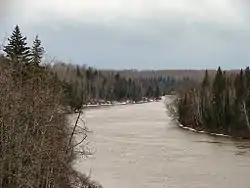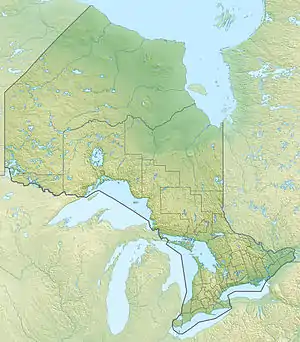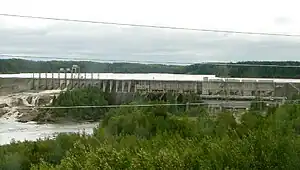Abitibi River
The Abitibi River is a river in northeastern Ontario, Canada, which flows northwest from Lake Abitibi to join the Moose River which empties into James Bay. This river is 540 kilometres (340 mi) long, and descends 265 metres (869 ft).[2] It is the fifth longest river entirely in Ontario
| Abitibi River | |
|---|---|
 Abitibi River at Iroquois Falls | |
 Location of the mouth of the Abitibi River in Ontario | |
| Etymology | Algonquin language |
| Location | |
| Country | Canada |
| Province | Ontario |
| District | Cochrane |
| Physical characteristics | |
| Source | Lake Abitibi |
| • location | 38 km east of Iroquois Falls |
| • coordinates | 48°47′06″N 80°10′23″W |
| Mouth | Moose River |
• location | 30 km SSW from Moosonee |
• coordinates | 51°04′17″N 80°55′32″W |
| Length | 540 m (1,770 ft) to head of Lac Loïs[1] |
| Basin size | 29,500 km2 (11,400 sq mi)[1] |
| Basin features | |
| Tributaries | |
| • left | Black River, Frederick House River, North Driftwood River |
| • right | Sucker River, Little Abitibi River |
Abitibi is an Algonquin word meaning "halfway water", derived from abitah, which may be translated as "middle" or "halfway", and nipi, "water". Originally used by the French to designate a band of Algonquin Indians who lived near the lake, the name was descriptive of their location halfway between the trading posts on the Hudson Bay and those on the Ottawa River.[2][3]
The river was an important fur trading route for the Hudson's Bay Company. Formerly, pulp and paper, centered on the town of Iroquois Falls, was an important industry in the heavily forested region through which it flows.[2] The region also supports tourism and gold mining.[2]
The Abitibi Canyon Generating Station is located on the river at Abitibi Canyon. The experience of surveying the river for the purposes of building this plant was the inspiration for folk singer Wade Hemsworth's "The Black Fly Song".
Geography
Description of river course (in downstream order):
- Begins as outlet from Lake Abitibi (48°47′6″N 80°10′23″W)
- Extreme southern point (48°42′26″N 80°38′25″W)
- Ansonville, Ontario (48°45′26″N 80°40′43″W)
- Iroquois Falls, Ontario (48°46′41″N 80°40′6″W)
- Crossed by Ontario Northland Railway (49°12′43″N 81°0′37″W)
- Long Sault Rapids hydroelectric plant (49°12′44″N 81°0′52″W)
- Confluence with the Black River (49°20′58″N 81°6′34″W)
- Confluence with the Frederick House River (49°18′51″N 81°16′58″W)
- Ontario Northland Railway crossing at Island Falls Station, Ontario (49°32′53″N 81°22′56″W)
- Island Falls, Ontario (49°34′3″N 81°23′16″W)
- Abitibi Canyon Generating Station near Fraserdale, Ontario (49°53′42″N 81°34′42″W)
- Otter Rapids Generating Station (50°10′57″N 81°38′37″W)
- Coral Rapids, Ontario (50°13′17″N 81°40′33″W)
- Extreme western point (50°15′25″N 81°40′48″W)
- Confluence with the Little Abitibi River (50°29′29″N 81°32′7″W)
- Joins the Moose River (51°4′17″N 80°55′32″W)
- Enters James Bay as part of the Moose River (51°21′14″N 80°24′14″W)
Tributaries
Protected areas
A small portion of the river (from the outlet of Lake Abitibi to Couchching Falls) is protected in the Abitibi-De-Troyes Provincial Park. Until April 2005, this park included all the public lands stretching along the Abitibi River to Iroquois Falls, but most of these were deregulated because the significant amount of private land within the area that made the management of the waterway class provincial park difficult.[4]
Power generation

The Abitibi River is used extensively for the hydro-electric power generation. Power stations on the river are in downstream order:
| Installation | Capacity | Head | Year built | Operator | Notes |
|---|---|---|---|---|---|
| Twin Falls | 27.5 MW | 17 m (56 ft) | 1922 | H2O Power | 5 vertical Francis turbines[5] |
| Iroquois Falls | 29.7 MW | 13 m (43 ft) | 1914 (rebuilt 2003) | H2O Power | 9 vertical Saxo Kaplan, 3 horizontal double Francis turbines[6] |
| Long Sault Rapids | 16 MW | 9 m (30 ft) | 1998 | Algonquin Power Systems | Run-of-the-river |
| Island Falls | 44.3 MW | 19 m (62 ft) | 1925 | H2O Power | 4 vertical Francis turbines[7] |
| Abitibi Canyon | 345 MW | 1933 | Ontario Power Generation | 5x 68.8 MW Francis turbines | |
| Peter Sutherland Sr. | 28 MW | 2017 | Ontario Power Generation | actually on New Post Creek[8] | |
| Otter Rapids | 180 MW | 1961 | Ontario Power Generation | 4x 45 MW turbines |
See also
References
- Atlas of Canada Archived 2007-04-04 at the Wayback Machine
- Hoiberg, Dale H., ed. (2010). "Abitibi River". Encyclopædia Britannica. Vol. I: A-ak Bayes (15th ed.). Chicago, Illinois: Encyclopædia Britannica Inc. pp. 33. ISBN 978-1-59339-837-8.
- Hamilton, William (1978). Canadian Place Names. Macmillan of Canada. p. 132. ISBN 0-7715-9754-1.
- "Abitibi-de-Troyes Provincial Park Management Statement". Ontario.ca. Ministry of the Environment, Conservation and Parks. 6 November 2015. Retrieved 20 September 2021.
- "Twin Falls Generating Station". h2opower.com. H2O Power. Retrieved 20 September 2021.
- "Iroquois Falls Generating Station". h2opower.com. H2O Power. Retrieved 20 September 2021.
- "Island Falls Generating Station". h2opower.com. H2O Power. Retrieved 20 September 2021.
- "Our projects: Peter Sutherland Sr. Generating Station". opg.com. Ontario Power Generation. Retrieved 20 September 2021.
External links
![]() Media related to Abitibi River at Wikimedia Commons
Media related to Abitibi River at Wikimedia Commons